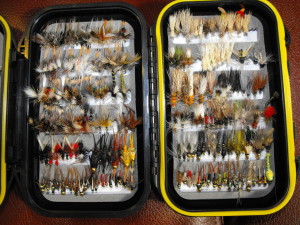“The height of cultivation always runs to simplicity.”
-Bruce Lee
I don’t know if the great Bruce Lee was a fly fisherman, but he certainly captured the essence of the sport in the above quote. Fly fishing is, at it’s core, the essence of “Man Versus Fish.”
It’s you, a rod, a small imitation of an insect, and your wits against the crafty, fresh water version of Moby Dick stalking the shadows of your favorite river. While your white whale may be a type of trout, a bass, or some other monster, the principle is the same—present your fly in the most enticing way possible for that season and that body of water.
Simplicity, obsession, and poetry in motion—but there is an insidious force that can easily creep in.
Becoming a Gear Head
 I’m not preaching here, and I’m not pointing fingers. This isn’t a holier than thou sermon from the pulpit of the snooty church of fly fishing.
I’m not preaching here, and I’m not pointing fingers. This isn’t a holier than thou sermon from the pulpit of the snooty church of fly fishing.
I’ve got rods that haven’t seen a river or felt a fish in over a year. I’ve got flies, either purchased or tied, that have never been allowed to float in their natural habitat. My vest has, at times, resembled a ruck sack on the back of an infantryman patrolling his assignment.
It’s easy to do…
Buying a bunch of crap that will likely never see the light of day is fun. Pouring over the latest issue of the Drake and dog-earing a few ads that will later liberate your wallet of a few greenbacks is a favorite pass time. In fact, it’s pretty much what we are designed to do.
But there is another way, and it can be, I believe, more rewarding.
The Light Bulb Moment
Standing in the middle of the river, cracking open one of the four fly boxes I had tucked in my vest, I started to feel an anxiety creep in.
I’d already thrown 4 flies in my first 45 minutes. All four were patterns I rarely used, but wanted to give a go. I put them in the right spots—even had a rainbow rise and have a peek, as if to say, “Hey, that’s interesting buddy, but I don’t eat interesting.” Yes, the prospect of being beaten by the ‘bows was becoming real.
I had to do it. What other choice did I have?
I pulled my hat off, and grabbed ol’ trusty—an olive wooly bugger I had nicknamed The Trout Whisperer.
This mesmerizing siren had pulled more fish from this spot than I can count. I was in need of those services again, and the Whisperer delivered as she had so many other times. Within 20 minutes, 15 inch and 10 inch rainbows came to pay their respects. The Whisperer once again ruled the day.
On my drive home, I did some thinking (don’t tell anyone!). I quickly realized the majority of my fish in that river came on a handful of flies. Looking back at my fishing journals (yes, I am that nerdy) the trend continued on other rivers in other seasons, albeit with different patterns.
That’s when The Challenge was born.
The Challenge
Arriving home, I started purging.
I won’t lie to you—this hurt. I hadn’t exercised my throwing out muscles in some time. If the apocalypse hits, I am prepared for 2 things: eating a lot of peanut butter, and fly fishing some empty rivers!
What I did was take those same 4 fly boxes, and divide them into seasons. So I had a winter box, a summer box, a fall and a spring. Then, I allowed myself to partition out 5 dry patterns, and 5 wet patterns for each season. So, I had 4 boxes and 40 flies. I grabbed the labeler that was an impulse buy at Staples (and that hadn’t even been opened for 7 months) and printed out each season.
I felt like I had slain a dragon, but all I really did was clear out some nonsense that I wasn’t likely to use anyway. But if I could be allowed the indulgence to claim an existential victory, I think I made more room for more fish.
My wife was pretty excited too…after all, creating a little more space is something she had been nagging me encouraging me to do for some time.
“Are the rods next?” she asked. Hold on there honey, let’s not get crazy. Those are our daughter’s inheritance.
And Now, Your Turn
So, four boxes, ten patterns each—5 dry, 5 wet.
What patterns would be included in your minimalist boxes? Let us know below.
See ya on the water…